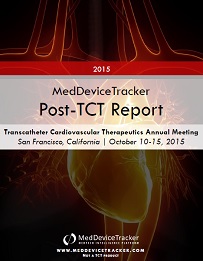Report Library
All Reports
2015 MedDeviceTracker Post-TCT Report
November 13, 2015
TCT was held this year from October 10-15 in San Francisco, CA. Coronary stents had the most new salient data at this year's TCT,
especially first data from the ABSORB III IDE
trial. Updated data for transcatheter aortic valve replacement (TAVR/TAVI) was more incremental, though 1 year data from Sapien 3's IDE
trial was also important. Peripheral drug-
eluting balloons showed signs of persistent efficacy in their second year, and HeartMate PHP, a potential competitor for Impella, had
interesting, albeit preliminary first data. For
presentations and abstracts not mentioned in this report but included in the MDT database, see the TCT 2015 Event List on page 36.
The bullets below provide highlights from these and other presentations.
Coronary Stents and Balloons
If interested in more information about MedDeviceTracker's medtech coverage, please visit www.meddevicetracker.com.
The bullets below provide highlights from these and other presentations.
Coronary Stents and Balloons
- In first data from the ABSORB III IDE trial, the Absorb (ABT) bioresorbable scaffold achieved non-inferiority with Xience on the primary
endpoint, target lesion failure (TLF) at 1
year. However, a higher numerical rate on TLF and a trend for more stent thrombosis raises questions, though operator experience could
contribute.
- While the device may still be approved, the FDA could want to see more data.
- Investigators acknowledge data from larger trials such as the ongoing ABSORB IV are needed to determine if there are clinically meaningful differences.
- Advantages with Absorb could still show up longer term, as the scaffold resorbs.
- The Dreams (Biotronik) absorbable metal scaffold encouragingly showed an improvement in late lumen loss (LLL) and other
measures
in
BIOSOLVE-II, compared to the
problematic first-generation stent.
- Still, LLL was on the high side, and longer term data from a larger study is needed to see if this makes any difference or if the bioresorbable metal scaffold as any advantages over bioresorbable polymeric ones, like Absorb.
- In the LEADERS FREE EU trial of patients at high risk of bleeding, the BioFreedom polymer free umirolimus-coated stent
encouragingly
showed superiority on target lesion
revascularization and MACE compared to a bare metal stent.
- Unfortunately, the recommendations for high risk bleeding patients had changed since the start of the trial, and the comparator bare metal stents are no longer favored. However, the investigator notes there is not good data for shortened DAPT with the current polymer coated drug-eluting stents, so he asserted that for high bleeding risk patients, BioFreedom was the best option available.
- Other coronary stent/balloon data:
- Positive imaging data from DESolve (Elixir) up to 36 months, but how much better is it than Absorb?
- Preliminary OCT data for MDT's polymer free Drug-filled Stent
- PANDA III Chinese study of the BuMa stent: more rapid drug elution and polymer absorption may reduce stent thrombosis
- ISAR-DESIRE 4: Angiosculpt (SPNC) scoring balloon provides a modest benefit for treatment of restenosis with the Pantera Lux (Biotronik) drug-coated balloon.
- One-year data from the Sapien 3 IDE trial showed a higher mortality rate than the recently reported CE Mark study, but that could be
due to higher risk patients. It is difficult to
say whether the valve has a clinical advantage over other new generation valves, though the disabling stroke rate was lower than what
has
been seen in competitor studies.
- Incremental data from the Evolut R (1-year) and Lotus (2-year) CE Mark studies and the Direct Flow registry (1-year) were without surprises.
- A study on reduced leaflet mobility published in the NEJM just before the conference suggested the cause was leaflet thrombosis that
could be prevented or treated with
anticoagulation
- It is still unclear how significant the finding is clinically. There was a suggestion from registry data that stroke/TIA rates could be higher in patients with the finding, but the strokes may have been procedure related instead.
- The finding was also seen in surgically placed valves.
- The FDA published a perspective reaffirming the benefit:risk of TAVR and further study is needed, though patients with certain clinical findings should be investigated.
- Data from the Sentinel (Claret) cerebral protection system's MISTRAL-C trial had signs suggesting a neurocognitive benefit versus no
protection, while reducing MRI lesion
volume and increasing the number of patients without any lesions.
- A more definitive study is needed. The investigator acknowledged it would be difficult to show a reduction in strokes (though a trend for that was seen in the study), but felt improved neurocognitive function would be an important endpoint.
- Lutonix (BCR) and IN.PACT Admiral (MDT) both encouragingly had 2 year data suggesting durable effects based on only small
changes
in target lesion revascularization.
- Primary patency may be dropping, though, in the Lutonix data, so longer term follow up will be important.
- Initial data for HeartMate PHP was presented for both the SHIELD I high-risk PCI trial, used to support its CE Mark, and a small initial experience in cardiogenic shock. While there were some encouraging preliminary data, with some signals that support could be better than Impella 2.5, these were only preliminary single-arm studies and there is some question about cases of new/worsening aortic insufficiency.
If interested in more information about MedDeviceTracker's medtech coverage, please visit www.meddevicetracker.com.
| Disease Group Covered: | Cardiovascular |
Additional Resources:
